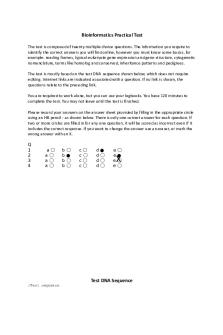Practical 8 Ferric Chloride TEST PDF

| Title | Practical 8 Ferric Chloride TEST |
|---|---|
| Author | YASMIN LIYANA BINTI / UPM |
| Course | Cell and Molecular Biology |
| Institution | Universiti Putra Malaysia |
| Pages | 3 |
| File Size | 103.8 KB |
| File Type | |
| Total Downloads | 107 |
| Total Views | 147 |
Summary
Ferric chloride test document full laboratory report...
Description
PRACTICAL 8: FERRIC CHLORIDE TEST Objective: To detect phenolic compounds in plant extract by ferric chloride test At the end of the practical, you should be able to: 1. Define what ferric chloride test is 2. Write a well-balanced equation reaction for ferric chloride test 3. Describe the methodology of the test and discuss the result obtained Introduction Iron (III) chloride is known as ferric chloride. Iron (III) ions form strongly coloured complexes with several organic compounds including phenol. The colour of the complexes varies from compound to compound. The reaction with iron (III) chloride solution can be used as a test for phenol. For instance, if you add a crystal of phenol to iron(III) chloride solution, you get an intense violet-purple solution formed. It is also important to understand that not all phenols will test positively in the presence of the FeCl3 reagent. A good example of this is in highly hindered phenols which do not yield positive tests. However, a negative test is not completely conclusive, so other tests can be performed to verify the absence of a phenol (such as NMR and IR spectroscopy). Activity 1. List down all the materials, apparatus, chemicals and reagents needed for this procedure. 2. Construct a simplified version of the procedure in a flow-chart form. Apparatus Mechanical blender Centrifuge Muslin cloth Rotary evaporator Test tube Test tube rack Dropper Material Preparation of extracts Boiling distilled water Plant leaves I. Iron (III) Chloride Test for Water-Soluble Phenols Phenol Plant extract Water 1% aqueous iron (III) chloride solution II. Iron(III) Chloride - Pyridine Test for Water-Insoluble Phenols Phenol Phenol Plant extract Methylene chloride 1% ferric chloride solution
Pyridine Methodology Preparation of extract: Cleaned leaves and aerial parts will be dried under shade and ground into a fine powder form using domestic mixer grinder machine. The fine powder of the plant leaves and aerial parts obtained was stored in air tight containers for further processing. Dried powdered leaves and aerial parts of the plant (80 g) was dispersed in boiled distilled water and cooled at room temperature in a closed glass container. The content was filtered with the help of double layered muslin cloth and the water infusion was collected. The solution was centrifuged at 5000 rpm for 10 minutes and the supernatant was collected for drying in the rotary vacuum evaporator at 60 ˚C temperature and low pressure. After complete evaporation of the water, the weight of the extracts was noted and the percent (%) of recovery of extracts was recorded on the dry weight basis. The extract was kept in air tight container and preserved in a refrigerator for further use. I. Iron (III) Chloride Test for Water-Soluble Phenols Standard Phenol Procedure The iron (III) chloride test for phenols is not completely reliable for acidic phenols, but can be administered by dissolving 15 mg of the plant extract in 0.5 mL of water or water-alcohol mixture and add 1 to 2 drops of 1% aqueous iron (III) chloride solution. Positive Test A red, blue, green, or purple colour is a positive test. II. Iron(III) Chloride - Pyridine Test for Water-Insoluble Phenols Phenol
Standard Phenol Procedure (for water-insoluble phenols or less reactive phenols) A more sensitive test for phenols consists of dissolving or suspending 15 mg of the plant extract in 0.5 mL of methylene chloride and adding 3-5 drops of a 1% solution ferric chloride in methylene chloride. Add a drop of pyridine and stir. Positive Test Addition of pyridine and stirring will produce a colour if phenols or enols are present. Results & Discussion 1. Describe the function of each chemical used in the experiment. 2. Discuss the observation of the colour changes in each test tube. 3. Define the reason of each step taken in the experiment (e.g. heating and cooling down of test tubes).
Conclusion Conclude the finding obtained from this practical SAFETY PRECAUTIONS Iron (III) chloride is toxic, highly corrosive and acidic. Ingestion of ferric chloride can result in serious morbidity and mortality....
Similar Free PDFs

Practical 8 Ferric Chloride TEST
- 3 Pages

Practical Test SPSS
- 7 Pages

Bioinformatics Practical Test
- 6 Pages

Potassium Chloride Drug Card
- 1 Pages

Chloride Imbalance
- 2 Pages

Practical - Lab reports 1-8
- 24 Pages

Test 8-12 - TEST
- 1 Pages

Test 4 – Data Analysis & Practical
- 16 Pages

Complete Notes for Practical Test
- 30 Pages

Poly Vinyl Chloride
- 56 Pages

Oxybutynin Chloride- Ditropan
- 1 Pages
Popular Institutions
- Tinajero National High School - Annex
- Politeknik Caltex Riau
- Yokohama City University
- SGT University
- University of Al-Qadisiyah
- Divine Word College of Vigan
- Techniek College Rotterdam
- Universidade de Santiago
- Universiti Teknologi MARA Cawangan Johor Kampus Pasir Gudang
- Poltekkes Kemenkes Yogyakarta
- Baguio City National High School
- Colegio san marcos
- preparatoria uno
- Centro de Bachillerato Tecnológico Industrial y de Servicios No. 107
- Dalian Maritime University
- Quang Trung Secondary School
- Colegio Tecnológico en Informática
- Corporación Regional de Educación Superior
- Grupo CEDVA
- Dar Al Uloom University
- Centro de Estudios Preuniversitarios de la Universidad Nacional de Ingeniería
- 上智大学
- Aakash International School, Nuna Majara
- San Felipe Neri Catholic School
- Kang Chiao International School - New Taipei City
- Misamis Occidental National High School
- Institución Educativa Escuela Normal Juan Ladrilleros
- Kolehiyo ng Pantukan
- Batanes State College
- Instituto Continental
- Sekolah Menengah Kejuruan Kesehatan Kaltara (Tarakan)
- Colegio de La Inmaculada Concepcion - Cebu




